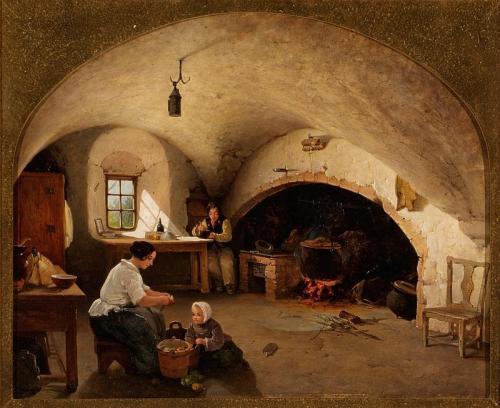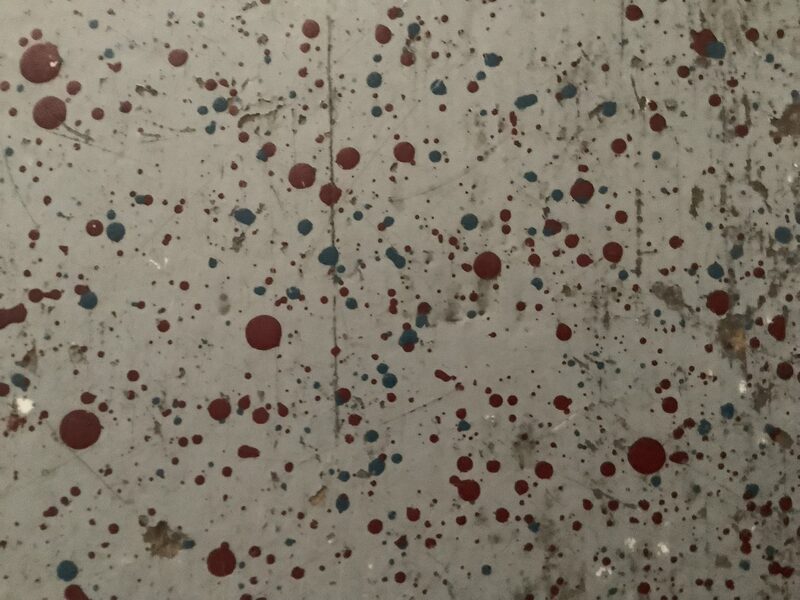Pennsylvania Dutch Kitchen, Inspiration
The Pennsylvania Dutch Kitchen dollhouse model accentuates ideals of the homestead during this time period. Alongside sufficiency and trade, the Pennsylvania Dutch held shared values of a close-knit family structure. Family members shared in daily responsibilities before a large, warm, open hearth, where meals were held and formal lessons were taught for the younger children of the family before laws were passed to require school-aged children to attend state schools.
The 'home' served as a work space, playing a key role in their survival through the harsher seasons. Thus, they were functional first, with every corner of the room being given purpose in the work: from wide work tables to storage.
What makes this dollhouse piece significant is that it is made entirely by Mrs. Fisher. While many of the pieces were bought or gifted to her, there are a few named pieces that Mrs. Fisher constructed herself by hand.
![<a href="/omeka/items/browse?advanced%5B0%5D%5Belement_id%5D=50&advanced%5B0%5D%5Btype%5D=is+exactly&advanced%5B0%5D%5Bterms%5D=A+Zoom+of+the+Hearth+in+the+Pennsylvania+Dutch+Kitchen%2C+Black+and+White%2C+by+Mrs.+Fisher%2C+%5Bca.+1940s-1950s%5D">A Zoom of the Hearth in the Pennsylvania Dutch Kitchen, Black and White, by Mrs. Fisher, [ca. 1940s-1950s]</a> <a href="/omeka/items/browse?advanced%5B0%5D%5Belement_id%5D=50&advanced%5B0%5D%5Btype%5D=is+exactly&advanced%5B0%5D%5Bterms%5D=A+Zoom+of+the+Hearth+in+the+Pennsylvania+Dutch+Kitchen%2C+Black+and+White%2C+by+Mrs.+Fisher%2C+%5Bca.+1940s-1950s%5D">A Zoom of the Hearth in the Pennsylvania Dutch Kitchen, Black and White, by Mrs. Fisher, [ca. 1940s-1950s]</a>](https://omeka.wilkes.edu/omeka/files/fullsize/69a5217aa1591623c0cf25396823205d.jpg)
A Zoom of the Hearth in the Pennsylvania Dutch Kitchen, Black and White, by Mrs. Fisher, [ca. 1940s-1950s]
![<a href="/omeka/items/browse?advanced%5B0%5D%5Belement_id%5D=50&advanced%5B0%5D%5Btype%5D=is+exactly&advanced%5B0%5D%5Bterms%5D=A+Magazine+Photograph+of+a+Hearth%2C+by+Life+Magazine%2C+1955+April+18%2C+clipped+by+Mrs.+Fisher%2C+%5Bca.+mid-late+twentieth+century%5D">A Magazine Photograph of a Hearth, by Life Magazine, 1955 April 18, clipped by Mrs. Fisher, [ca. mid-late twentieth century]</a> <a href="/omeka/items/browse?advanced%5B0%5D%5Belement_id%5D=50&advanced%5B0%5D%5Btype%5D=is+exactly&advanced%5B0%5D%5Bterms%5D=A+Magazine+Photograph+of+a+Hearth%2C+by+Life+Magazine%2C+1955+April+18%2C+clipped+by+Mrs.+Fisher%2C+%5Bca.+mid-late+twentieth+century%5D">A Magazine Photograph of a Hearth, by Life Magazine, 1955 April 18, clipped by Mrs. Fisher, [ca. mid-late twentieth century]</a>](https://omeka.wilkes.edu/omeka/files/fullsize/50bdfe41abeff65148ba691189eb7b35.jpg)
This picture above depicts a stone and brick hearth. The image was found in a Dollhouse Scrapbook, part 1, created by Mrs. Fisher circa the mid-late twentieth century. The original photograph was from a Life Magazine, artcile entitled, "The Practical World of the Colonists," published 1955 April 18.
For the hearth, she did so by collecting rocks from her driveway and structuring them to mirror the hearths she had researched:
Fisher also painted a splatter-floor design to mimic the staggered patterns that were favored to hide messes during the period.
A historical blog written by the Westport Historical Society explains the purpose behind the floor style’s creation:
"The technique had many practical advantages: providing camouflage for dirt, inexpensive and easy to clean. It is especially well-suited to rural homesteads and managing the annual cycles of tracking in mud, snow, ice or sand. It is also well suited to the Yankee sensibility: a do-it-yourself /make-do mentality, as it required little skill, providing a way to use up left-over paint and promoting the efficient use of supplies that was far cheaper than carpet or rugs."
This inclusion is interesting as it is a style derived from the early 20th century. This reveals Mrs. Fisher’s preference in design rather than historical accuracy, however, it blends the cultural conversation that the Pennsylvania Dutch Kitchen embodies, and shows us her attention to detail.
Fisher captures those details affectionately with a fully set table and small touches, like an embroidered sign of “Home Sweet Home.”
This miniature focuses on the heart of the home: the kitchen. But what about a larger community? Look no further than Mrs. Fisher’s recreation of the County Store!

![<a href="/omeka/items/browse?advanced%5B0%5D%5Belement_id%5D=50&advanced%5B0%5D%5Btype%5D=is+exactly&advanced%5B0%5D%5Bterms%5D=A+Clipping+from+a+Newspaper+Article+titled%2C+%E2%80%9CMrs.+Dwight+Fisher%E2%80%99s+Collection+to+be+Seen%2C%E2%80%9D+%5Bca.+mid-late+twentieth+century%5D">A Clipping from a Newspaper Article titled, “Mrs. Dwight Fisher’s Collection to be Seen,” [ca. mid-late twentieth century]</a> <a href="/omeka/items/browse?advanced%5B0%5D%5Belement_id%5D=50&advanced%5B0%5D%5Btype%5D=is+exactly&advanced%5B0%5D%5Bterms%5D=A+Clipping+from+a+Newspaper+Article+titled%2C+%E2%80%9CMrs.+Dwight+Fisher%E2%80%99s+Collection+to+be+Seen%2C%E2%80%9D+%5Bca.+mid-late+twentieth+century%5D">A Clipping from a Newspaper Article titled, “Mrs. Dwight Fisher’s Collection to be Seen,” [ca. mid-late twentieth century]</a>](https://omeka.wilkes.edu/omeka/files/fullsize/330c62b1ba74772790aff6635addf17a.jpg)

![<a href="/omeka/items/browse?advanced%5B0%5D%5Belement_id%5D=50&advanced%5B0%5D%5Btype%5D=is+exactly&advanced%5B0%5D%5Bterms%5D=A+Capture+of+Mrs.+Fisher%27s+Recreation+of+Spatter+Floor+Detailing%2C+%5Bca.+mid+1940s-1950s%5D">A Capture of Mrs. Fisher's Recreation of Spatter Floor Detailing, [ca. mid 1940s-1950s]</a> <a href="/omeka/items/browse?advanced%5B0%5D%5Belement_id%5D=50&advanced%5B0%5D%5Btype%5D=is+exactly&advanced%5B0%5D%5Bterms%5D=A+Capture+of+Mrs.+Fisher%27s+Recreation+of+Spatter+Floor+Detailing%2C+%5Bca.+mid+1940s-1950s%5D">A Capture of Mrs. Fisher's Recreation of Spatter Floor Detailing, [ca. mid 1940s-1950s]</a>](https://omeka.wilkes.edu/omeka/files/fullsize/eba00a04584d2ba5172249b5f50b0749.jpg)
![<a href="/omeka/items/browse?advanced%5B0%5D%5Belement_id%5D=50&advanced%5B0%5D%5Btype%5D=is+exactly&advanced%5B0%5D%5Bterms%5D=A+Zoom+Capture+of+the+Home+Sweet+Home+and+Table+Recreations+by+Mrs.+Fisher%2C+%5Bca.+1940s-1950s%5D">A Zoom Capture of the Home Sweet Home and Table Recreations by Mrs. Fisher, [ca. 1940s-1950s]</a> <a href="/omeka/items/browse?advanced%5B0%5D%5Belement_id%5D=50&advanced%5B0%5D%5Btype%5D=is+exactly&advanced%5B0%5D%5Bterms%5D=A+Zoom+Capture+of+the+Home+Sweet+Home+and+Table+Recreations+by+Mrs.+Fisher%2C+%5Bca.+1940s-1950s%5D">A Zoom Capture of the Home Sweet Home and Table Recreations by Mrs. Fisher, [ca. 1940s-1950s]</a>](https://omeka.wilkes.edu/omeka/files/fullsize/a4425799fbf0798e25267ed83270705c.jpg)